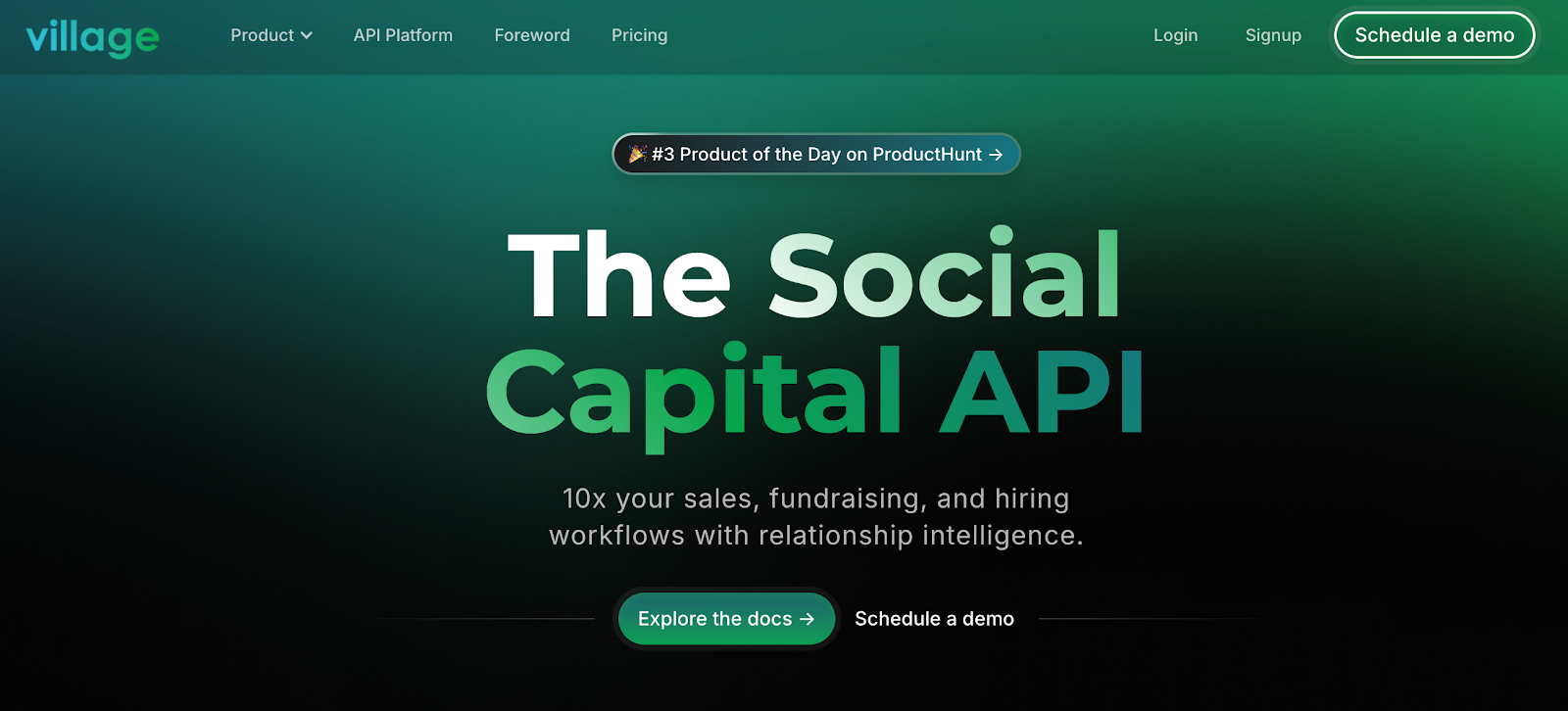Reaching out to someone you don’t know can feel like a shot in the dark. Whether you’re applying for a job, pitching a product, or looking for an investor, getting a response can be tough. But what if you had someone to vouch for you?
A warm introduction puts you on the radar of the right people by connecting you through a shared contact. However, finding the right introduction is not always easy. Village helps professionals, businesses, and sales teams unlock valuable connections and close more deals.
So, how do you make the most of a warm introduction? Learn how Village can help you secure better introductions faster.
What Is a Warm Introduction?
A warm introduction is when a mutual contact personally connects you with someone, giving you an immediate advantage.
Instead of starting from scratch, you’re stepping into a meaningful connection with built-in credibility. This approach works in business, sales, hiring, and networking, or any situation where existing relationships matter.
Why Are Warm Introductions So Effective?
Have you ever ignored a cold email or LinkedIn request from someone you didn’t know? Most people do. When there’s no prior connection, it’s easy to dismiss a message, no matter how relevant it might be.
A warm introduction changes that by adding credibility. When a trusted contact makes the introduction, it signals that you are worth their time. Instead of being just another message in a crowded inbox, you arrive with immediate trust already in place.
This approach makes conversations more natural and opens doors that might otherwise remain closed. Whether you are looking for a new job, a business partnership, or an investment opportunity, having someone vouch for you can strengthen your valuable connections.
Types of Warm Introductions
Reaching out to someone through mutual contact can happen in different ways. Some introductions are based on past work experience, while others come from personal or professional networks. How you are introduced can shape the conversation and the way the other person perceives you.
Choosing the right type of introduction for your situation can help set the right expectations. Here are a few common approaches:
Referral Introduction
A referral happens when someone recommends you for a job, business opportunity, or partnership. It carries weight because it comes from a trusted source.
Hiring managers, decision-makers, and sales professionals often pay more attention to referrals than to cold outreach.
Personal Connection Introduction
This introduction comes from a mutual friend, colleague, or industry contact who connects two people based on a personal relationship.
Mutual connections are useful for expanding networks, building partnerships, or starting meaningful conversations in a more relaxed setting. Since personal trust is involved, these introductions often lead to better engagement.
Past Collaboration Introduction
Someone who has worked with you before can introduce you to a new contact by sharing their experience with you.
A former colleague, client, or business partner can vouch for your skills, reliability, and professionalism. This type of introduction is helpful for freelancers, consultants, and professionals transitioning to new roles.
Warm Introduction Email
Some introductions happen over email instead of in person or on a call. A well-structured email from a mutual contact sets up the conversation by providing background on both parties and why the introduction is happening.
A thoughtful introduction email makes it easier to establish common ground between two parties.
How to Ask for a Warm Introduction
Reaching out to someone through mutual contact can feel uncertain. You don’t want to come across as pushy, but you also need to be clear about why you’re asking. A well-placed request increases the chances that your contact will agree to make the introduction.
The key is to be thoughtful in your approach. Instead of asking casually, take a moment to prepare. Here’s how to ask in a way that makes it easy for your contact to say yes.
Identify the Right Contact for the Introduction
Before making a request, find the best person to connect you. Look for someone who has a good relationship with the person you want to reach. A strong mutual connection leads to a better introduction and a higher chance of engagement.
If you’re unsure who to ask, tools like LinkedIn connections can help you see mutual contacts. However, not all connections on LinkedIn reflect strong relationships, and some may not be close enough to provide a warm introduction.
Instead, platforms like Village go beyond surface-level connections by mapping real relationships within your extended network. This makes it easier to find the right person who can introduce you with trust and credibility.
Professional groups, networking events, and past colleagues can also be valuable sources.
Craft a Clear and Professional Request
Be direct about why you are asking for an introduction. Tell your contact who you want to meet and why the connection matters. Keep your message short, polite, and specific.
For example, instead of saying, "Can you introduce me to John?" try, "I see that you’ve worked with John in the past. I’d love to connect with him to discuss a venture capital opportunity. If you’re comfortable making an introduction, I’d really appreciate it.”
Respect Their Time and Decisions
Not everyone will be able to make the introduction, and that’s okay. Some contacts may not feel close enough to the person or may not be comfortable making the connection. If they decline, thank them anyway and move on.
If they agree, make it easy for them by offering a short introduction they can forward. A well-written introduction saves them time and increases the likelihood of a strong connection.
How to Get a Warm Introduction With Village
With Village, getting a warm introduction is simple. Instead of searching through contacts, Village finds the best people to introduce you to the right connections. Once you set up your account, follow these steps to make better introductions:
1. Sync Your Contacts to Find Trusted Connections
Connect your existing networks to see who can introduce you to investors, partners, or clients. Village integrates with:
- Google Contacts
- Google Calendar
- People You Email
- LinkedIn Connections
2. Tap Into Your Investor Network
Join 14,000+ portfolio networks on Village to find introductions through fellow founders, co-investors, and other professionals in your industry.
3. Combine Your Team’s Networks
Bring together contacts from your team, advisors, and investors to uncover third-degree connections that may lead to valuable introductions. Village helps you:
- Search across your team’s network
- Find introductions through investors and co-founders
- Expand reach using trusted contacts
4. Use AI to Discover Hidden Relationships
Village’s AI-powered technology identifies connections you may have missed, even if those people haven’t joined Village. You can find:
- Work overlaps with potential partners
- VC-founder funding relationships
- Founder-founder portfolio connections
5. Request a Warm Introduction in Seconds
Once you find the right contact, send a warm introduction request directly through Village.
Schedule a demo today to learn more about what you can achieve with Village.
How to Follow Up After a Warm Introduction
A warm introduction gives you a direct connection, but what you do next determines where the conversation goes. Following up the right way keeps the momentum going and shows that you value the opportunity.
Respond Quickly and Show Appreciation
Once an introduction is made, reply as soon as possible. A slow response can make you seem uninterested or unprepared. A quick acknowledgment within a day keeps the conversation active.
Start by thanking both the person who introduced you and the new contact. A simple message like “I appreciate the introduction, and I’m looking forward to connecting” sets a positive tone. Expressing gratitude makes it more likely that people will introduce you again in the future.
Keep the Conversation Focused
Once the introduction is made, take the next step. If a meeting or call makes sense, suggest a time while keeping it flexible. If the discussion happens over email, ask an open-ended question that invites a response.
Instead of saying, “Let me know when you're free,” try, “Would you be available for a quick call next week? I'm happy to work around your schedule.” Being clear about the next steps makes it easier for the conversation to move forward.
Follow Up Without Being Overbearing
If you don’t hear back, wait a few days before sending a brief, polite follow-up. People get busy, and messages can be overlooked. A short reminder brings your request back to their attention without making it feel like pressure.
If they don’t respond after a follow-up or two, step back and move on. Not every introduction will turn into an immediate opportunity, but leaving a good impression keeps the door open for future conversations.
Avoid These Mistakes in Warm Introductions
Warm introductions can open doors, but they need to be handled with care. A poorly managed introduction can make a bad impression, damage relationships, or even close off future opportunities.
Avoid these common mistakes to help keep your professional network strong:
Being Too Pushy or Demanding
No one likes to feel pressured into making an introduction. If someone seems hesitant, respect their decision. A warm introduction should be voluntary, not something a contact feels obligated to do.
Instead of insisting, ask in a way that gives them an easy way out. For example, “If you’re comfortable making the introduction, I’d really appreciate it” allows them to decline without awkwardness.
Not Providing Enough Context
When asking for an introduction, be clear about why you want to connect. A vague request puts the burden on your contact to figure out what to say, making them less likely to help.
Provide a short explanation of who you are, what you’re looking for, and why the introduction makes sense. A well-structured request makes it easier for your contact to forward your message without rewriting it.
Forgetting to Follow Up
If someone takes the time to introduce you, don’t leave them wondering if it went anywhere. Let them know when the conversation is happening, and thank them again for the connection.
A quick follow-up message like, “Thanks again for the introduction. We had a great conversation, and I appreciate your help,” shows professionalism and keeps relationships strong.
Using Warm Introductions for Sales Pitches Without Permission
If someone introduces you to a new contact, don’t turn it into an unexpected sales pitch unless it is clear from the start. A warm introduction is built on trust, and pushing a sale too soon can make both you and your contact look bad.
If business is the goal, frame the conversation as an opportunity to learn about each other rather than jumping into a pitch. A thoughtful approach keeps the door open for future discussions.
Village helps you avoid these mistakes by guiding you through the introduction process. Try it now!
Why Warm Introductions Are More Valuable Than Ever
Cold outreach is becoming less effective. Whether you’re applying for jobs, looking for investors, or generating sales leads, reaching out without a prior connection often leads to silence. People are more likely to respond when the introduction comes from someone they already trust.
Warm introductions help professionals and businesses tap into their existing networks to make stronger real-life connections. Many platforms, from job boards to sales tools, could benefit from making these introductions easier.
The challenge is that people often don’t know who in their network can connect them to the right person.
Technology can help solve this problem by mapping relationships and making warm introductions more accessible.
Turn Every Connection Into an Opportunity With Village

Warm introductions don’t have to be left to chance. The right connections already exist. You just need a way to find them.
Village makes this easy by mapping real relationships and helping users discover who in their network can introduce them to the right people.
Village’s Social Graph API (application programming interface) can:
- Unlock valuable introductions by identifying mutual contacts who can make trusted connections.
- Integrate network intelligence with a single line of code to show users who in their network can introduce them to the right people.
- Drive engagement and revenue by offering warm intro features, making it easier for businesses to connect users while creating monetization opportunities.
Whether it’s job seekers, recruiters, sales teams, or startups, warm introductions create stronger connections and better outcomes. Don’t let valuable opportunities get lost in cold outreach.
By automating lead generation and helping users find potential clients, Village makes every introduction more effective.
Want to see how Village can facilitate more warm introductions for your platform? Schedule a demo today!
FAQs About Warm Introduction
What is a warm intro?
A warm introduction is when a mutual contact personally connects you with someone, helping establish trust and credibility from the start. Instead of reaching out cold, you’re introduced by someone who already has a relationship with the person you’re trying to connect with.
What is a warm vs cold intro?
A warm introduction happens through a shared contact, which makes it more likely to lead to a response and a productive conversation. In contrast, a cold introduction means reaching out to someone without any prior relationship, which often results in a lower response rate.
Compared to a warm introduction, cold calling is far less effective because there’s no existing trust or relationship between parties.
How to give a warm introduction?
A warm introduction should provide context and make both parties feel comfortable. It typically includes a short message or email that explains who the person is, why the introduction is being made, and how they might benefit from connecting. Keeping it brief and relevant helps set the right tone.
What is a good starting introduction?
Start with a simple and clear message, such as:
"Hi [Name], I’d like to introduce you to [Person’s Name]. [He/She/They] is [a short description of their background or role]. I thought you two should connect because [reason for introduction]. I’ll let you both take it from here!"
A warm introduction should feel natural and make it easy for both people to continue the conversation.








